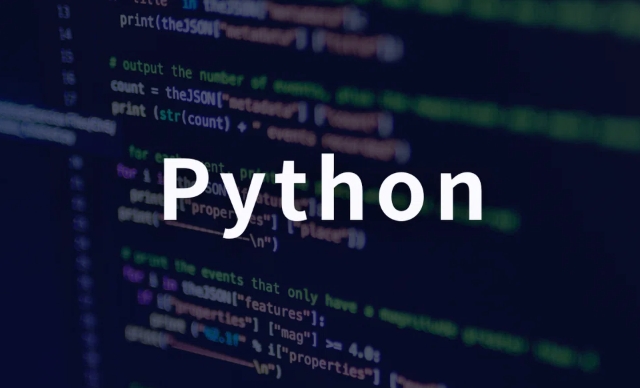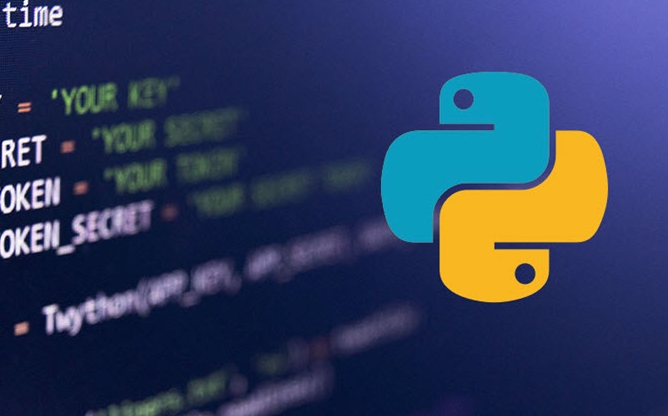The container orchestration for deploying Python applications is actually not complicated. The core is to make the container run stably and collaborate well. The first step is to package the application into a Docker image, write Dockerfile installation dependencies, copy code, and set up startup commands. Then choose the right orchestration tool. Kubernetes is the mainstream solution for multi-service scenarios, while Docker Compose, Nomad, or AWS's ECS/Fargate is more suitable for lightweight or stand-alone deployments. In terms of configuration management, it is recommended to split configuration files by environment and use ConfigMap and Secret to separate non-sensitive and sensitive information. Inter-service communication should be completed through the internal Service name to avoid exposing the public IP. Finally, automated deployment and health checks are crucial, including automatic restart (livenessProbe), automatic scaling (HPA), and integrated CI/CD pipelines to achieve continuous delivery, ensuring stable and efficient system operation.

Deploying Python applications with container orchestration is actually not that mysterious. To put it bluntly, let multiple containers run and cooperate well, and can automatically recover and expand capacity. For Python applications, especially web services (such as Django, Flask), using container orchestration can save a lot of effort in operation and maintenance.

Here are some common perspectives in actual use.
Containing your Python application is the first step
No matter what orchestration tool is used, the application must be packaged into a mirror. Python applications usually practice to write a Dockerfile in the root directory of the project, install dependencies, copy code, expose ports, and set startup commands.

To give a simple example:
FROM python:3.10-slim WORKDIR /app COPY requirements.txt . RUN pip install -r requirements.txt COPY . . CMD ["gunicorn", "app:app"]
This image can be built locally and run tests:

-
docker build -t my-python-app . -
docker run -p 8000:8000 my-python-app
After confirming that there is no problem, you can push it to the mirror repository (such as Docker Hub or private repository) for subsequent deployment.
Kubernetes is the mainstream choice, but don't ignore lightweight solutions
Speaking of container orchestration, Kubernetes (K8s for short) is almost the default option. It has powerful functions and supports advanced functions such as automatic scaling, rolling updates, and service discovery. It is suitable for multi-service and high-concurrency scenarios.
However, if you just want to deploy Python applications on stand-alone or small-scale clusters, you can consider a lighter solution, such as:
- Docker Compose : Suitable for local development and small deployments. By configuring YAML files, you can define services, networks, volume mounts, etc.
- Nomad : HashiCorp's scheduling tool is simpler than K8s and supports multiple task types.
- ECS/Fargate : If you are already using AWS, you can directly deploy containers with managed services without maintaining nodes by yourself.
Choose the right tool for different scenarios, and don’t use K8s as soon as you come up, sometimes it will increase the complexity.
Configuration files and service management should be clear
Whether it is K8s or Docker Compose, the configuration file is recommended to split by environment (dev, test, prod) to avoid hard-code sensitive information.
For example, in K8s, the recommended approach is:
- Use ConfigMap to store non-sensitive configurations (such as environment variables)
- Use Secret to store sensitive data such as passwords and keys
- References to these configurations in a Deployment or Pod definition
This can achieve "one-time build, multiple environment deployment" and reduce problems caused by configuration errors.
In addition, communication between services must be planned well. For example, the front-end adjustment back-end API can be accessed in the cluster through the Service name, and there is no need to expose the public IP.
Automated deployment and health checks must not be missing
The key to truly stable operation lies in automation and monitoring. Deployment does not mean that everything is good. You must also ensure:
- It can automatically restart when the application crashes (implemented through livenessProbe in K8s)
- Can automatically scale up and down according to load (HPA, based on CPU/memory or custom metrics)
- Try to automate the deployment process, such as CI/CD pipeline integration
Taking GitHub Actions K8s as an example, you can set up a workflow, automatically build the image after pushing to the main branch, push it to the repository, and trigger the K8s update deployment.
In this way, you only need to submit the code and leave the rest to the system for processing.
Basically that's it. Container orchestration sounds complicated, but in fact the core logic is "how to make containers run well." Although Python applications are not heavy, they are becoming more and more common under the microservice architecture. Mastering this deployment method will make your project easier to expand and maintain.
The above is the detailed content of Container Orchestration for Python Applications. For more information, please follow other related articles on the PHP Chinese website!

Hot AI Tools

Undress AI Tool
Undress images for free

Undresser.AI Undress
AI-powered app for creating realistic nude photos

AI Clothes Remover
Online AI tool for removing clothes from photos.

Clothoff.io
AI clothes remover

Video Face Swap
Swap faces in any video effortlessly with our completely free AI face swap tool!

Hot Article

Hot Tools

Notepad++7.3.1
Easy-to-use and free code editor

SublimeText3 Chinese version
Chinese version, very easy to use

Zend Studio 13.0.1
Powerful PHP integrated development environment

Dreamweaver CS6
Visual web development tools

SublimeText3 Mac version
God-level code editing software (SublimeText3)

Hot Topics
 Polymorphism in python classes
Jul 05, 2025 am 02:58 AM
Polymorphism in python classes
Jul 05, 2025 am 02:58 AM
Polymorphism is a core concept in Python object-oriented programming, referring to "one interface, multiple implementations", allowing for unified processing of different types of objects. 1. Polymorphism is implemented through method rewriting. Subclasses can redefine parent class methods. For example, the spoke() method of Animal class has different implementations in Dog and Cat subclasses. 2. The practical uses of polymorphism include simplifying the code structure and enhancing scalability, such as calling the draw() method uniformly in the graphical drawing program, or handling the common behavior of different characters in game development. 3. Python implementation polymorphism needs to satisfy: the parent class defines a method, and the child class overrides the method, but does not require inheritance of the same parent class. As long as the object implements the same method, this is called the "duck type". 4. Things to note include the maintenance
 Python Function Arguments and Parameters
Jul 04, 2025 am 03:26 AM
Python Function Arguments and Parameters
Jul 04, 2025 am 03:26 AM
Parameters are placeholders when defining a function, while arguments are specific values ??passed in when calling. 1. Position parameters need to be passed in order, and incorrect order will lead to errors in the result; 2. Keyword parameters are specified by parameter names, which can change the order and improve readability; 3. Default parameter values ??are assigned when defined to avoid duplicate code, but variable objects should be avoided as default values; 4. args and *kwargs can handle uncertain number of parameters and are suitable for general interfaces or decorators, but should be used with caution to maintain readability.
 Explain Python generators and iterators.
Jul 05, 2025 am 02:55 AM
Explain Python generators and iterators.
Jul 05, 2025 am 02:55 AM
Iterators are objects that implement __iter__() and __next__() methods. The generator is a simplified version of iterators, which automatically implement these methods through the yield keyword. 1. The iterator returns an element every time he calls next() and throws a StopIteration exception when there are no more elements. 2. The generator uses function definition to generate data on demand, saving memory and supporting infinite sequences. 3. Use iterators when processing existing sets, use a generator when dynamically generating big data or lazy evaluation, such as loading line by line when reading large files. Note: Iterable objects such as lists are not iterators. They need to be recreated after the iterator reaches its end, and the generator can only traverse it once.
 Python `@classmethod` decorator explained
Jul 04, 2025 am 03:26 AM
Python `@classmethod` decorator explained
Jul 04, 2025 am 03:26 AM
A class method is a method defined in Python through the @classmethod decorator. Its first parameter is the class itself (cls), which is used to access or modify the class state. It can be called through a class or instance, which affects the entire class rather than a specific instance; for example, in the Person class, the show_count() method counts the number of objects created; when defining a class method, you need to use the @classmethod decorator and name the first parameter cls, such as the change_var(new_value) method to modify class variables; the class method is different from the instance method (self parameter) and static method (no automatic parameters), and is suitable for factory methods, alternative constructors, and management of class variables. Common uses include:
 How to handle API authentication in Python
Jul 13, 2025 am 02:22 AM
How to handle API authentication in Python
Jul 13, 2025 am 02:22 AM
The key to dealing with API authentication is to understand and use the authentication method correctly. 1. APIKey is the simplest authentication method, usually placed in the request header or URL parameters; 2. BasicAuth uses username and password for Base64 encoding transmission, which is suitable for internal systems; 3. OAuth2 needs to obtain the token first through client_id and client_secret, and then bring the BearerToken in the request header; 4. In order to deal with the token expiration, the token management class can be encapsulated and automatically refreshed the token; in short, selecting the appropriate method according to the document and safely storing the key information is the key.
 What are Python magic methods or dunder methods?
Jul 04, 2025 am 03:20 AM
What are Python magic methods or dunder methods?
Jul 04, 2025 am 03:20 AM
Python's magicmethods (or dunder methods) are special methods used to define the behavior of objects, which start and end with a double underscore. 1. They enable objects to respond to built-in operations, such as addition, comparison, string representation, etc.; 2. Common use cases include object initialization and representation (__init__, __repr__, __str__), arithmetic operations (__add__, __sub__, __mul__) and comparison operations (__eq__, ___lt__); 3. When using it, make sure that their behavior meets expectations. For example, __repr__ should return expressions of refactorable objects, and arithmetic methods should return new instances; 4. Overuse or confusing things should be avoided.
 How does Python memory management work?
Jul 04, 2025 am 03:26 AM
How does Python memory management work?
Jul 04, 2025 am 03:26 AM
Pythonmanagesmemoryautomaticallyusingreferencecountingandagarbagecollector.Referencecountingtrackshowmanyvariablesrefertoanobject,andwhenthecountreacheszero,thememoryisfreed.However,itcannothandlecircularreferences,wheretwoobjectsrefertoeachotherbuta
 Python `@property` decorator
Jul 04, 2025 am 03:28 AM
Python `@property` decorator
Jul 04, 2025 am 03:28 AM
@property is a decorator in Python used to masquerade methods as properties, allowing logical judgments or dynamic calculation of values ??when accessing properties. 1. It defines the getter method through the @property decorator, so that the outside calls the method like accessing attributes; 2. It can control the assignment behavior with .setter, such as the validity of the check value, if the .setter is not defined, it is read-only attribute; 3. It is suitable for scenes such as property assignment verification, dynamic generation of attribute values, and hiding internal implementation details; 4. When using it, please note that the attribute name is different from the private variable name to avoid dead loops, and is suitable for lightweight operations; 5. In the example, the Circle class restricts radius non-negative, and the Person class dynamically generates full_name attribute






